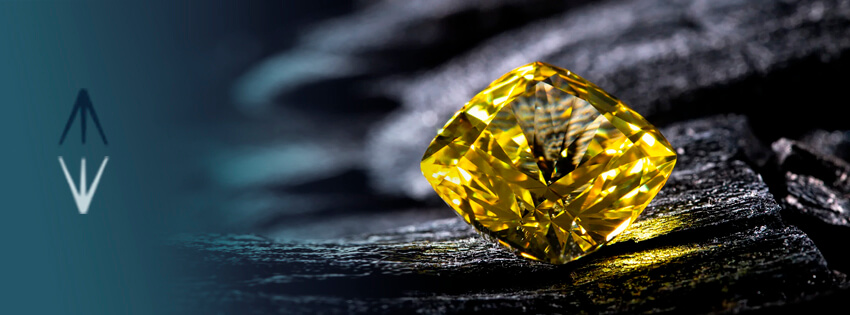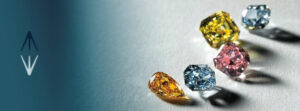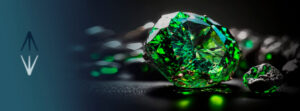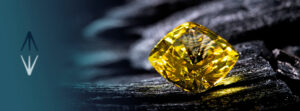Yellow diamonds, also known as “canary diamonds,” are one of the most cherished and sought-after variants in the world of gemstones. With a vibrant color ranging from pale yellow to intense yellow, these diamonds have captured the attention of collectors and jewelers alike. In this article, we will explore what yellow diamonds are, their distinctive characteristics, history, origin, market value, and how they should be cared for to maintain their brilliance.
What Are Yellow Diamonds?
Yellow diamonds are diamonds that have a distinctive yellow hue due to the presence of nitrogen in their crystalline structure. This element absorbs blue light and emits a yellow color, giving rise to this beautiful diamond variant. The intensity of the color can vary, and diamonds with intense yellow color are the most valuable within this category.
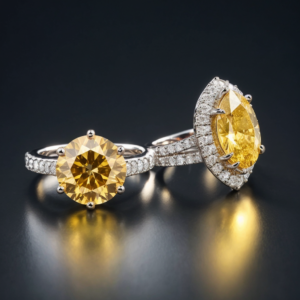
Characteristics of Yellow Diamonds
- Color: Color is the most distinctive factor in yellow diamonds. These can range from pale yellow to intense yellow, known as Fancy Vivid Yellow. The more saturated and vivid the color, the higher the diamond’s value.
- Clarity: As with other diamonds, the clarity of yellow diamonds varies. However, inclusions may be less visible in darker-colored diamonds, which can affect their value.
- Cut: The cut is crucial for highlighting the color of yellow diamonds. Cuts such as cushion and radiant are popular for maximizing color intensity.
- Carat: The carat weight of yellow diamonds can vary widely. As with all diamonds, greater carat weight generally means higher value, especially if the color is vibrant.
History and Origin of Yellow Diamonds
Yellow diamonds have a rich history dating back centuries, highly valued for their brilliance and distinctive color. Over the years, these diamonds have caught the attention of royalty, collectors, and jewelers, becoming symbols of luxury and prestige.
Discovery of Yellow Diamonds
Yellow diamonds have been discovered in various regions around the world, but South Africa has played a particularly crucial role in the history of these gems. In the late 19th century, South Africa became the epicenter of diamond mining, and the Kimberley mine emerged as one of the most important sources of yellow diamonds.
- Kimberley Mine: Known as the “Great Kimberley Mine” or “Big Hole,” this mine has been one of the most productive in diamond history. It was in this mine that some of the most iconic yellow diamonds were discovered, including the famous Tiffany Yellow Diamond. This diamond, weighing 128.54 carats, is one of the most recognized yellow diamonds in the world, known for its vivid color and impeccable clarity.
- Other Important Deposits: Although South Africa is the best-known source, yellow diamonds have also been found in other regions such as Australia, particularly in the Argyle mine, and in Brazil. These discoveries have contributed to the availability of yellow diamonds in the global market.
- Rise in Popularity: Throughout the 20th century, yellow diamonds gained popularity in high-end jewelry. Celebrities and royalty began showcasing these gems at important events, elevating their status and increasing demand.
Evolution of Value and Recognition
Over the years, yellow diamonds have evolved from being a rarity appreciated for their vibrant color to becoming a symbol of luxury and exclusivity. Advances in mining and cutting have made these diamonds more accessible, although the rarest and most intensely colored examples remain extremely valuable.
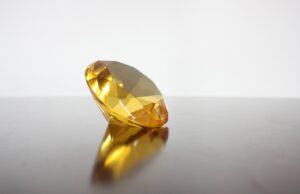
Today, yellow diamonds continue to be sought after for their uniqueness and beauty, and their history is marked by notable discoveries and a growing demand in the gemstone market. These diamonds not only represent a valuable investment but also a legacy of history and elegance that transcends time.
Formation and Coloration Process of Yellow Diamonds
Yellow diamonds, like all diamond varieties, form in the depths of the Earth’s mantle, approximately 150-200 kilometers below the surface. Here, the conditions of high pressures and temperatures, which can exceed 1000 degrees Celsius, allow pure carbon to crystallize into diamond form. This process, which takes millions of years, is the origin of all diamond gemstones we know today.
The Role of Nitrogen in Yellow Diamond Coloration
The key to the yellow coloration in these diamonds is the presence of nitrogen atoms in their crystalline structure. During the crystallization process, when carbon atoms organize themselves into the diamond’s crystal lattice, small groups of nitrogen atoms can incorporate into the structure.
- Interaction with Light: Nitrogen absorbs certain wavelengths of light, particularly in the blue part of the spectrum, resulting in the diamond reflecting yellow light. This is why the amount and arrangement of nitrogen atoms can affect the intensity of the yellow color, from a pale shade to an intense and vibrant yellow.
- Variety in Coloration: Yellow diamonds can vary in color from a soft, almost golden tone to a Fancy Vivid Yellow, which is a deep, saturated yellow. The more intense the coloration, the more valuable the diamond. The rarity of these stones increases even further in cases where the color is perfectly uniform without lighter or darker zones.
- Unique Formation: Unlike other colored diamonds, such as blue or green ones, whose coloration comes from elements like boron or hydrogen, yellow diamonds are unique due to the exclusive influence of nitrogen. This aspect makes them especially desirable gems for those who appreciate natural-colored stones.
Value and Market of Yellow Diamonds
In today’s gemstone market, yellow diamonds have established themselves as a sophisticated and coveted choice for both jewelers and collectors. The popularity of these diamonds has grown exponentially, driven in part by the demand for unique-colored gems and the aesthetic appeal they bring to jewelry.
Factors Determining the Value of a Yellow Diamond
The value of a yellow diamond is influenced by several critical factors, which together determine its appeal and market price:
- Color Intensity: Color is the most important factor in determining the value of a yellow diamond. Diamonds classified as Fancy Vivid Yellow, which exhibit a strong and vibrant yellow, are the most valuable. The color grading for yellow diamonds ranges from Fancy Light, Fancy, Fancy Intense, and Fancy Vivid, with a progressive increase in value and rarity.
- Clarity: Although color is paramount, clarity also plays a significant role. Diamonds with high clarity, showing few or no visible inclusions under a 10x magnifying glass, are more prized and therefore more valuable.
- Cut: A good cut maximizes the beauty of a yellow diamond, enhancing its color and brilliance. Cuts that allow light to reflect better within the diamond, such as the emerald cut or cushion cut, are particularly popular for these diamonds, as they can accentuate the color.
- Size or Carat: As with all diamonds, carat weight is a determining factor. Larger, heavier yellow diamonds are rare, and when combined with intense color and good clarity, they can fetch exceptionally high prices.
Current Market and Trends in Yellow Diamonds
Yellow diamonds have been highly sought after in auctions and private sales, with prices reflecting their rarity and the growing appreciation for colored diamonds.
- Jewelry Trends: The popularity of yellow diamonds has led to an increase in their use in high-end jewelry. Renowned designers and luxury brands are increasingly incorporating these gems into their collections, which in turn drives up the value of yellow diamonds in the market.
- Investment in Yellow Diamonds: As an investment, yellow diamonds offer significant potential, especially those that combine intense color with good clarity and size. Sales records for yellow diamonds have shown notable increases in recent years, with some specimens reaching record prices at auctions.
In summary, yellow diamonds represent a unique combination of beauty, rarity, and value, making them a desirable choice for both fine jewelry and long-term investment.
The Most Famous Yellow Diamonds
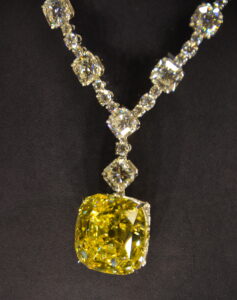
- Tiffany Yellow Diamond: Weighing 128.54 carats, this is one of the most famous yellow diamonds in the world. It was discovered in the Kimberley mine and is known for its intense yellow color and exceptional clarity.
- The Allnatt Diamond: This diamond weighs 101.29 carats and is a Fancy Vivid Yellow color. It was named after its former owner, Major Alfred Ernest Allnatt.
- The Incomparable Diamond: Although not entirely yellow, this brown-yellow diamond weighs 407.48 carats and is one of the largest diamonds in the world. It was discovered in the Democratic Republic of Congo.
Meaning and Symbolism of Yellow Diamonds
Yellow diamonds are often associated with happiness, positivity, and energy. Their vibrant yellow color evokes the sun and is seen as a symbol of prosperity, joy, and optimism. In jewelry, a yellow diamond can be a symbol of creativity and a free spirit, representing a bright and energetic personality.
Care and Maintenance of Yellow Diamonds
To maintain the beauty and value of a yellow diamond, it is essential to follow proper care practices:
- Regular Cleaning: Clean your yellow diamond with a soft cloth and specific jewelry solutions. Avoid harsh chemicals that could affect the diamond’s color or surface.
- Safe Storage: Store the diamond in a safe place, preferably in a padded jewelry box to avoid scratches and impacts. Keep it separate from other jewelry to prevent damage.
- Certification: Ensure that your yellow diamond is certified by a recognized authority, such as the GIA (Gemological Institute of America), to verify its authenticity and quality.
- Insurance: Consider insuring your diamond against potential damage, theft, or loss. This will provide peace of mind and financial protection in case of any incident.
Frequently Asked Questions about Yellow Diamonds
What makes a diamond yellow?
Yellow diamonds get their color from the presence of nitrogen in their crystalline structure, which causes the absorption of blue light and results in a yellow color.
Are yellow diamonds more valuable than colorless diamonds?
Yellow diamonds can be more valuable than colorless diamonds, especially if they have intense color and high clarity. However, value depends on several factors, including color, cut, clarity, and carat weight.
Where are yellow diamonds found?
Yellow diamonds have been found in various regions of the world, including South Africa, Australia, and Brazil. Some of the most famous mines producing yellow diamonds include the Kimberley mine in South Africa.
How should I care for a yellow diamond?
Yellow diamonds should be regularly cleaned with gentle solutions, stored safely, and preferably be certified and insured to maintain their value and appearance.
Conclusion on Yellow Diamonds
Yellow diamonds are exceptional gems that combine vibrant beauty with deep symbolic meaning. From their fascinating formation process to their growing value in the market, these diamonds continue to be a popular choice for jewelry that stands out. With proper care, a yellow diamond can retain its stunning appearance and high value, ensuring it remains cherished for generations.

